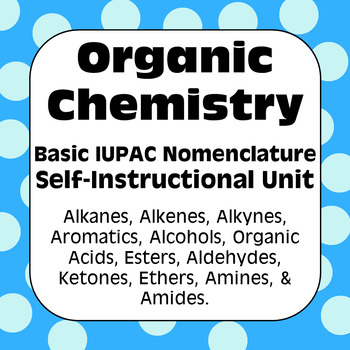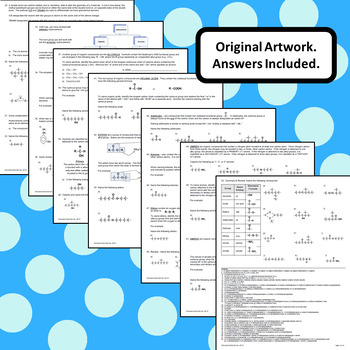Chemical Nomenclature: Self-guided Unit for High School Organic Chemistry
- PDF
- Easel Activity
What educators are saying
Also included in
- A series of scaffolded, hands-on, and visual activities and lessons for biochemistry, senior biology, and/or chemistry students.Please see individual files for additional details.⭐Click here to follow my store & receive the latest updates Original Artwork (©AwesomeScience). For Personal Use OnlyPrice $72.90Original Price $81.00Save $8.10
Description
Updated with current IUPAC nomenclature. This self-instructional unit with step-by-step instructions, examples, problems and room for student answers, is an effective introduction to organic chemistry nomenclature especially for senior/AP biology, biochemistry, and chemistry students. Use it prior to your unit on biochemistry/functional groups. This package covers the following compounds: alkanes, alkenes, alkynes, aromatics, alcohols, organic acids, esters, aldehydes, ketones, ethers, amines, & amides.
Works well with the following activities:
Functional Groups in Biological Molecules: Draw & Identify
Building Biological Macromolecules: Carbohydrates
Building Biological Macromolecules: Lipids
Building Biological Macromolecules: Proteins
Building Biological Macromolecules: Nucleic Acids
Building Biological Macromolecules: All Biomolecules
Click here to follow my store and receive the latest updates.
Original Artwork (©AwesomeScience). For Personal Use Only. Uneditable.
Page count does not include Terms of Use and links to supplementary activities.
Copyright ©AwesomeScience 2013 – The Present.
All Rights Reserved by Author.
By using this Resource you agree to the Terms as outlined in the Terms of Service. This Resource is for limited Personal Use only; not to be used, in part or in whole, for commercial purposes. Each Individual License is for use by one specific educator only. Additional licenses must be purchased for each additional educator. Except as permitted in Section 3 to deliver Resources electronically to Permitted Recipients, you may not post or otherwise make the Resource available on any website, application, shared drive or other sites or services.






